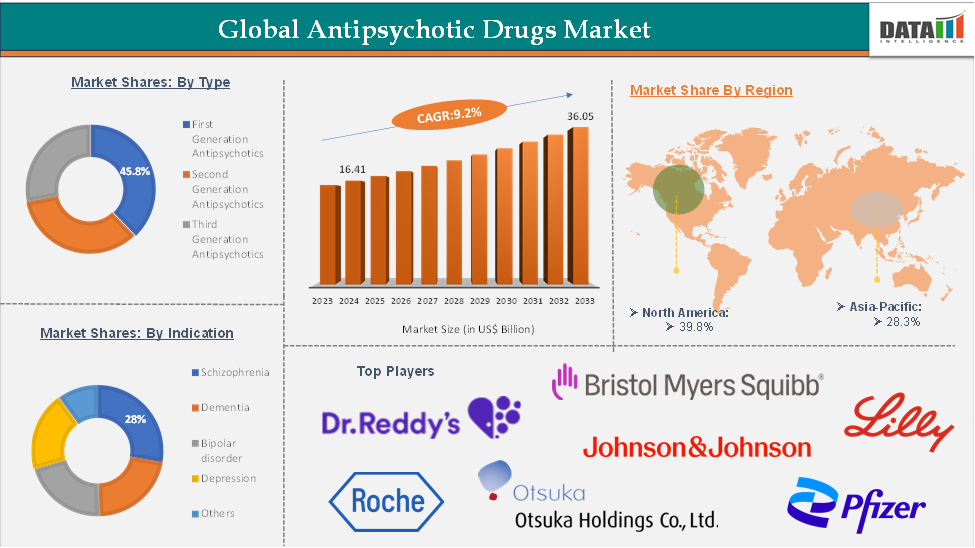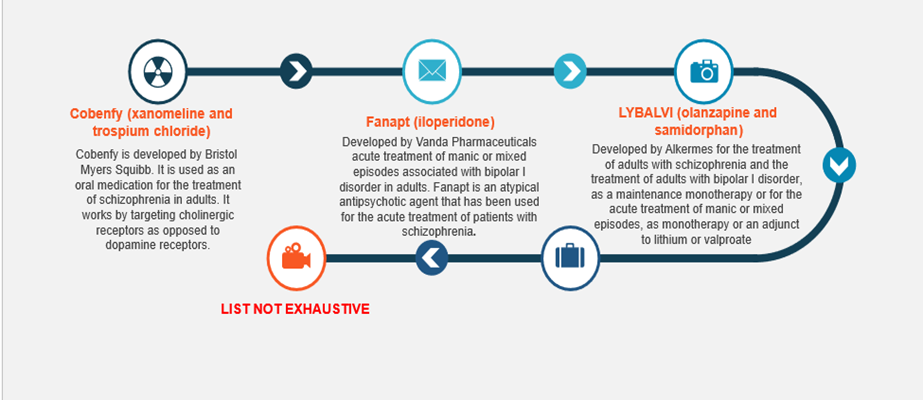Antipsychotic Drugs Market Size - Industry Trends & Outlook
Antipsychotic Drugs Market size reached US$ 16.41 Billion in 2024 and is expected to reach US$ 36.05 Billion by 2033, growing at a CAGR of 9.2% during the forecast period 2025-2033, according to DataM Intelligence report.
Antipsychotic drugs, commonly known as painkillers, are a class of drugs designed to relieve pain. They work by blocking pain signals in the body or by altering the way the brain interprets those signals. These medications come in various forms, ranging from over-the-counter to prescription medications. These medications can be taken orally, parenterally, and topically.
The global antipsychotic drugs market is experiencing steady growth, driven by the rising prevalence of mental health disorders such as schizophrenia, bipolar disorder, and severe depression. Increased awareness, improved diagnosis rates, and greater access to mental healthcare are contributing to the expanding demand for effective treatment options. Overall, the market is expected to grow steadily over the coming years, with key players focusing on next-generation therapies and improved delivery mechanisms to enhance patient adherence and treatment efficacy.
Executive Summary

For more details on this report – Request for Sample
Antipsychotic Drugs Market Dynamics: Drivers & Restraints
Introduction of innovative antipsychotic drugs is expected to significantly drive the antipsychotic drugs market growth
The introduction of innovative antipsychotic drugs is expected to significantly drive growth in the antipsychotic drugs market, supported by a range of compelling factors. Pharmaceutical companies are increasingly developing advanced therapies capable of addressing multiple mental health disorders with improved efficacy and tolerability. For instance, in April 2023, Teva and MedinCell received FDA approval for UZEDY (risperidone), an extended-release, long-acting subcutaneous atypical antipsychotic injection for the treatment of schizophrenia in adults. These next-generation medications offer enhanced tolerability, which is essential for maintaining patient adherence and improving long-term outcomes.
Technological advancements in drug formulation and delivery methods have also led to the development of long-acting injectables, which reduce dosing frequency and support sustained therapeutic effects. This not only improves patient compliance but also broadens treatment options for complex psychiatric conditions. For instance, in September 2024, Bristol Myers Squibb received the U.S. Food and Drug Administration (FDA) approval for COBENFY (xanomeline and trospium chloride), an oral medication for the treatment of schizophrenia in adults. COBENFY represents the first new class of medicine in several decades and introduces a fundamentally new approach to treating schizophrenia by selectively targeting M1 and M4 receptors in the brain without blocking D2 receptors.
Lack of awareness of mental health conditions is expected to hinder the antipsychotic drugs market
The lack of awareness regarding mental health conditions is anticipated to significantly impede the growth of the antipsychotic drugs market. Many individuals suffering from psychiatric disorders, such as schizophrenia and bipolar disorder, often do not recognize their symptoms or understand the critical importance of seeking treatment. This gap in awareness can lead to underdiagnosis and undertreatment, resulting in a smaller patient population that requires antipsychotic therapies. Consequently, pharmaceutical companies may struggle to expand their market reach and drive sales effectively.
Antipsychotic Drugs Market Segment Analysis
The global antipsychotic drugs market is segmented based on type, indication, route of administration, and region.
Type:
The second-generation antipsychotic drugs segment is expected to hold 45.8% of the market share in 2024 in the antipsychotic drugs market
The second-generation antipsychotic drugs (SGAs) segment is poised to maintain its dominant position in the antipsychotic drugs market, primarily due to their enhanced safety profiles and greater efficacy compared to first-generation antipsychotics (FGAs). Second-generation antipsychotics (SGAs) are a newer class of antipsychotic medications used to treat schizophrenia, bipolar disorder, and related psychiatric conditions.
The ongoing product launches and advancements in drug development are expected to further propel the growth of SGAs, with a notable increase in long-acting injectable formulations that improve patient adherence and treatment outcomes. For instance, in March 2025, Vanda Pharmaceuticals Inc. announced the submission of a New Drug Application (NDA) to the U.S. Food and Drug Administration (FDA) seeking marketing approval for Bysanti (milsaperidone). The application covers the treatment of acute bipolar I disorder and schizophrenia. The NDA is backed by multiple clinical studies evaluating the efficacy and safety of Bysanti, highlighting its potential as a new therapeutic option for patients with serious mental health conditions.
Thus, the above factors are expected to show a promising dominance of SGAs in the antipsychotic market in the future, supported by a shift towards innovative treatment options that prioritize both efficacy and safety for patients.
Antipsychotic Drugs Market Geographical Analysis
North America is expected to dominate the global antipsychotic drugs market with a 39.8% share in 2024
North America is expected to maintain a dominant position in the global antipsychotic drugs market. This dominance is driven by several key factors, including a high prevalence of psychiatric disorders such as schizophrenia and bipolar disorder, which affect millions of people in the region.
North America has a well-established healthcare infrastructure and a strong presence of leading biopharmaceutical companies that are continuously innovating and launching new products. For instance, in April 2024, Vanda Pharmaceuticals Inc. received the U.S. Food and Drug Administration (FDA) approval for Fanapt (iloperidone) tablets for the acute treatment of manic or mixed episodes associated with bipolar I disorder in adults. Fanapt is an atypical antipsychotic agent that has been used for the acute treatment of patients with schizophrenia.
Pharmaceutical companies in the region are actively developing advanced treatment solutions that have gained significant trust among patients, largely due to the strong reputation of these brands. For example, in March 2025, Teva Pharmaceuticals reported encouraging feedback from both patients and healthcare professionals regarding its Phase 3 SOLARIS study evaluating TEV-‘749, a subcutaneous extended-release olanzapine injection. The survey revealed that over 92% of patients, 87% of nurses, and 72% of physicians expressed satisfaction with the treatment, particularly highlighting its initiation regimen, monthly dosing schedule, and flexible dosing options.
North America's healthcare system supports extensive research and development initiatives aimed at creating safer and more effective antipsychotics, including long-acting injectable formulations that improve patient adherence to treatment.
Antipsychotic Drugs Market Top Companies
Top companies in the Antipsychotic Drugs market include Bayer AG, Teva Pharmaceutical Industries Ltd., Dr. Reddy’s Laboratories Ltd., Hikma Pharmaceuticals PLC, Lupin, Cipla, Sanofi, AdvaCare Pharma, Wellona Pharma, and Montage Laboratories Pvt. Ltd, among others.
Key Developments
In December 2024, Intra-Cellular Therapies, Inc., a biopharmaceutical company focused on central nervous system disorders, submitted a supplemental New Drug Application to the FDA seeking approval for Caplyta (lumateperone) as an additional treatment for Major Depressive Disorder (MDD) in adults.
Approved Drugs

Market Scope
Metrics | Details | |
CAGR | 9.2% | |
Market Size Available for Years | 2022-2033 | |
Estimation Forecast Period | 2025-2033 | |
Revenue Units | Value (US$ Bn) | |
Segments Covered | Type | First Generation Antipsychotics, Second Generation Antipsychotics, Third Generation Antipsychotics |
Indication | Schizophrenia, Dementia, Bipolar disorder, Depression, and Others | |
Route of Administration | Oral, Parenteral | |
Regions Covered | North America, Europe, Asia-Pacific, South America, and the Middle East & Africa | |
The global antipsychotic drugs market report delivers a detailed analysis with 54 key tables, more than 45 visually impactful figures, and 159 pages of expert insights, providing a complete view of the market landscape.